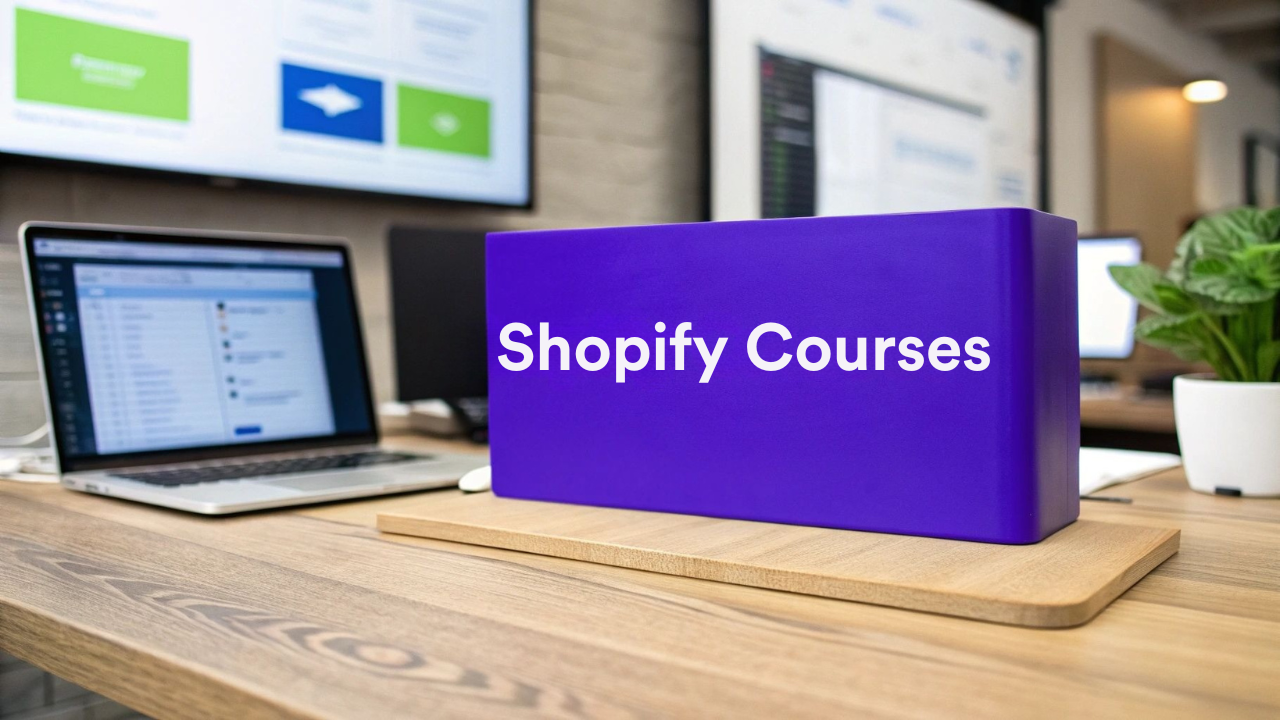Why Shopify Is Becoming the Go-To Platform for Course Creators
More and more course creators are turning to Shopify to host and sell their online courses. This shift towards an eCommerce platform traditionally known for physical products might seem surprising. But the reasons behind this trend lie in Shopify’s evolving features and the unique benefits it provides for educators looking for an all-in-one solution. This means managing your entire course business – from marketing and sales to delivery and student management – all in one place. Check out this guide on how to sell courses on Shopify for more information.
Seamless Integration and Customization
One of Shopify’s biggest draws is its seamless integration with various apps designed for course creation and delivery. Creators can transform their Shopify stores into robust learning platforms without needing complex coding or technical expertise.
Shopify's highly customizable themes also empower educators to create branded learning environments that truly connect with their target audience. You can tailor everything – the look and feel of your course pages, the checkout process, and even the student dashboards – to match your brand identity.
Streamlined Payment Processing and Business Management
Shopify offers a simplified payment processing system, handling all transactions securely and efficiently. This eliminates the need for third-party payment gateways, reducing administrative overhead. You can focus on developing and delivering high-quality courses instead of getting tangled in financial complexities.
When considering selling courses on Shopify, understanding the broader eCommerce landscape is key. The global eCommerce market is massive and continues to expand. In 2024, global ecommerce sales are projected to hit $6.09 trillion, presenting a significant opportunity for online businesses, including those selling courses. Shopify holds a substantial 10.32% share of this global market, making it a powerful platform for course creators. For more insights, see this information on global ecommerce sales.
Flexibility for Diverse Learning Formats
Shopify's flexibility extends to supporting a wide range of course formats. From video lessons and downloadable workbooks to live webinars and interactive quizzes, Shopify adapts to various learning styles. This adaptability allows creators to offer a rich and engaging learning experience.
It's important to note that while Shopify excels at the business side of selling courses, integration with a dedicated learning management system (LMS) may be necessary for advanced features. These features might include progress tracking, student community forums, and course completion certificates.
To better understand the advantages and potential limitations of Shopify for course creators, let's compare it to some dedicated course platforms.
To help you make an informed decision, we've compiled a comparison table showcasing the key differences and similarities between Shopify and popular dedicated course platforms.
| Feature | Shopify | Teachable | Thinkific | Podia |
|---|---|---|---|---|
| Pricing | Varies based on plan and apps | Paid plans | Paid plans | Paid plans |
| Built-in Course Features | Requires apps | Yes | Yes | Yes |
| Payment Processing | Built-in | Integrated | Integrated | Integrated |
| Customization | High, through themes and apps | Moderate | Moderate | Moderate |
| Marketing Tools | Extensive, through apps | Built-in | Built-in | Built-in |
| Community Features | Requires apps | Limited | Limited | Limited |
| eCommerce Integrations | Seamless | Limited | Limited | Limited |
As the table illustrates, Shopify offers significant advantages in terms of eCommerce features and customization, while dedicated course platforms generally offer more robust built-in features specific to online learning. Choosing the right platform will depend on your specific needs and priorities as a course creator.
Setting Up Your Course Business: From Concept to Launch

Selling courses successfully on Shopify depends on having a solid setup. This includes choosing the right Shopify plan, integrating key apps, and optimizing your store for smooth course delivery. This section provides a practical guide to navigating these essential steps, ensuring a seamless and successful course launch.
Choosing the Right Shopify Plan
Shopify offers a variety of plans, each with its own pricing and features. Picking the right plan for your course business is essential to avoid unnecessary costs. The Basic Shopify plan is often a good starting point for new course creators. It provides the core tools you need to build a functional online store and start selling.
As your business expands, you might consider upgrading to the Shopify plan or the Advanced Shopify plan. These plans offer more advanced reporting features and lower transaction fees. They also provide features that can simplify your operations as your number of students grows. When making your decision, consider your projected sales and the level of support you’ll need.
Essential Apps for Course Delivery
Turning your Shopify store into a thriving learning platform requires the right apps. Tevello seamlessly integrates courses and communities directly into your Shopify store. This streamlined approach simplifies the customer experience and creates opportunities for upselling and cross-selling. Tevello offers features like customizable learning paths, interactive workshops, and reliable video hosting, making it a suitable solution for various course formats.
Other apps focus on specific needs. Some specialize in membership management, allowing you to offer tiered access to your course content. Others provide enhanced student engagement features like quizzes, progress tracking, and certificates. Exploring these options allows you to customize your Shopify store to meet the specific needs of your course and your target audience.
Hosting Your Course Content
How you choose to host your course content affects both the student experience and your business’s efficiency. While Shopify allows for direct hosting of some digital downloads, dedicated platforms like Tevello or other learning management system (LMS) integrations often offer more advanced features. These might include secure video hosting, protected download links, and streamlined content delivery within the Shopify environment.
Choosing your hosting platform is a bit like choosing the right venue for an event. A coffee shop might work for a small gathering, but a larger venue is needed for a bigger crowd. The format and complexity of your course will determine the best hosting approach. For instance, video-heavy courses benefit from platforms with robust video hosting and streaming capabilities. Downloadable resources are best managed with secure delivery systems to protect your intellectual property and provide easy student access.
Addressing Technical Challenges
Technical problems can disrupt your course launch and lead to student frustration. Anticipating common challenges and having solutions in place is crucial. For instance, make sure your chosen Shopify theme is compatible with the apps you’ll be using for course delivery. Test the checkout process to guarantee a seamless purchase experience.
Also, think about how students will access course materials after purchasing. Will they receive automated emails with login details or will access be provided within their Shopify account? Clearly outlining these processes helps avoid confusion and creates a positive student experience. Just as a well-organized backstage area contributes to a smooth performance, addressing the technical details behind the scenes will ensure a positive experience for your course participants.
Crafting Courses That Actually Sell (And Students Love)

Building a successful online course business on Shopify involves more than just the technical setup. It requires careful planning and a deep understanding of your target audience's needs. This means developing courses that not only generate sales but also deliver genuine value, cultivating a loyal student base and encouraging positive word-of-mouth referrals.
Understanding Your Ideal Student
Successful course creators start by truly understanding their ideal student. This goes beyond simple demographics. It involves identifying their pain points, aspirations, and preferred learning styles.
For example, a course aimed at entrepreneurs might concentrate on practical skills and real-world applications. A course designed for artists, on the other hand, could prioritize creative exploration and individual expression.
Structuring Your Course for Success
Once you understand your audience, you can effectively structure your course content. This often means breaking down complex topics into smaller, easily digestible modules.
Each module should have clear learning objectives and build upon previous lessons, creating a logical flow. This structured approach makes the learning experience more manageable and keeps students engaged.
- Modular Learning: Break down content into bite-sized pieces.
- Clear Objectives: Define specific learning outcomes for each module.
- Logical Progression: Ensure lessons build upon each other seamlessly.
Creating Irresistible Course Packaging
Just like any product, how you present your course can significantly impact sales. This involves writing compelling course descriptions and developing preview content that showcases the value of what you're offering.
Highlighting testimonials from satisfied students and showing the positive changes they experienced builds trust and provides powerful social proof. Consider bundling your course with valuable extras or offering tiered pricing options. This not only caters to different budgets but also increases the perceived value, potentially leading to higher sales. Learn more in our article about how to master online course pricing strategies.
Pricing Strategies for Shopify Courses
Setting the right price for your Shopify course is essential for profitability. A price that's too low can undervalue your expertise, while a price that's too high can discourage potential students. Check out this article: How to master online course pricing strategies to learn more about pricing strategies that work for Shopify.
Factors to consider include your target audience's budget, the perceived value of your course, and the pricing of similar courses. Experimenting with different pricing models, like one-time purchases, subscriptions, or payment plans, can also help you find the best approach for your specific course and target market.
Addressing Pain Points and Creating Buying Moments
Ultimately, a successful course addresses a real problem for your ideal student. By understanding their challenges and demonstrating how your course offers solutions, you create irresistible buying moments.
This might involve showcasing the tangible benefits students can expect, such as increased income, improved skills, or personal growth. This resonates far more effectively than simply listing features or topics covered. By focusing on the transformative potential of your course, you can connect with potential students emotionally and inspire them to invest in their learning.
Marketing Your Shopify Courses to the Right Audience

Developing a top-notch online course is a significant first step, but it's only half the journey. For your course to truly flourish, you need a solid marketing strategy that connects with the right students. This involves understanding your target audience, utilizing appropriate marketing channels, and optimizing your Shopify store for maximum impact, turning curious browsers into enrolled students.
Identifying Your Target Audience
Before you dive into marketing, take the time to define your ideal student. Consider their demographics, interests, and learning goals. Understanding where they spend their time online is crucial. This information will inform your messaging and guide your marketing efforts. For instance, if your course is designed for young professionals, LinkedIn might be a better platform to focus on than TikTok.
Also, think about their pain points and aspirations. How can your course help them overcome challenges and reach their objectives? Centering your marketing message around these benefits will resonate more effectively than simply listing course features.
Leveraging Effective Marketing Channels
Once you have a firm grasp of your target audience, you can strategically select the most effective marketing channels. Email marketing remains a powerful tool for nurturing leads and fostering connections with potential students. Craft compelling email sequences that offer valuable content, highlight course benefits, and encourage enrollment.
Content marketing, such as writing informative blog posts or hosting free webinars related to your course topic, builds your credibility and draws organic traffic to your Shopify store. This also enhances your search engine optimization (SEO), making it easier for prospective students to discover your courses. Shopify's built-in SEO tools, such as customizable meta descriptions and title tags, can further boost your online visibility.
Don't overlook the potential of social media marketing. Focus on the platforms where your target audience is most active and create engaging content that promotes your courses. Paid advertising on platforms like Facebook and Instagram can also broaden your reach significantly.
Optimizing Your Shopify Store
Your Shopify store is a crucial part of your marketing ecosystem. Develop dedicated landing pages tailored to each course. These pages should clearly outline the course benefits, showcase student testimonials, and feature a clear call to action. This focused approach encourages conversions by minimizing distractions.
For further insights, explore resources like this guide on How to master online course marketing. Furthermore, consider integrating Shopify apps that enrich the learning experience and promote student engagement. Features like progress trackers, quizzes, and community forums can add tremendous value.
Building a Community
Cultivating a sense of community around your courses can significantly amplify your marketing efforts. Encourage interaction among students through forums, live Q&A sessions, or social media groups. This creates a supportive learning environment and fuels positive word-of-mouth referrals. Satisfied students become your most effective advocates, attracting new learners. By consistently providing value and engaging with your students, you can build a loyal following and create a thriving online course business within your Shopify store.
Maximizing Revenue During Peak Buying Seasons
Selling courses on Shopify offers a powerful advantage: the ability to capitalize on peak buying seasons. These periods of increased consumer spending represent golden opportunities to boost revenue. By understanding seasonal buying psychology and strategically positioning your courses, you can achieve significant sales growth.
The Psychology of Seasonal Buying
Consumers are more inclined to purchase during certain times of the year. Holidays, back-to-school season, and the New Year all trigger increased spending. These periods often evoke emotions related to self-improvement, gift-giving, or fresh starts. This presents a valuable opening for course creators.
For example, courses on personal development or acquiring new skills align well with New Year's resolutions. Similarly, hobby or creative courses make thoughtful gifts during the holiday season.
Limited-Time Promotions and Urgency
Creating urgency is a powerful sales tactic during peak seasons. Limited-time promotions, like discounts or bonus content, can encourage immediate purchases. However, it's essential to balance driving sales with maintaining the perceived value of your courses.
Offering too many discounts can diminish your expertise. Instead, focus on adding value through extras like exclusive webinars or downloadable resources.
Strategic Calendar for Course Promotions
A strategic promotional calendar is key to maximizing revenue. Certain course types naturally fit with specific seasonal interests. To help visualize this, let's look at a sample promotional calendar. The table below provides a framework for aligning course types, discounts, and marketing efforts with relevant seasons and events.
To help illustrate how to effectively plan your promotions, here’s a sample Course Promotion Calendar: This table provides a strategic overview of how to align your course types, discounts, and marketing efforts with relevant seasons and events throughout the year.
| Season/Event | Course Types to Promote | Discount Strategy | Marketing Focus |
|---|---|---|---|
| New Year's | Health, Fitness, Personal Finance, Career Advancement | Early Bird Discounts, Package Deals | Goal Setting, New Beginnings |
| Spring | Gardening, Home Improvement, Outdoor Activities | Percentage Discounts, Free Bonus Modules | Renewal, Growth |
| Summer | Travel, Cooking, Creative Pursuits | Bundled Offers, Limited-Time Sales | Leisure, Exploration |
| Back-to-School | Academic Subjects, Study Skills, Professional Development | Student Discounts, Referral Programs | Skill Enhancement, Career Advancement |
| Holidays | Crafting, Cooking, Gift-Giving, Family Activities | Gift Certificates, Holiday Bundles | Family, Celebration |
This calendar provides a flexible template. You can adapt it based on your specific course offerings and target audience. The goal is to create a roadmap that proactively anticipates consumer demand and maximizes revenue opportunities.
Preparing Your Shopify Store
Before the rush of peak seasons, ensure your Shopify store is ready for increased traffic and conversions. This involves a few key preparations:
- Optimizing your website speed to handle a surge in visitors.
- Streamlining your checkout process for efficiency and reduced cart abandonment.
- Providing adequate customer support to handle inquiries promptly.
By preparing your store and using a strategic promotional calendar, you can effectively maximize revenue during peak buying seasons. This approach not only boosts sales but also expands your reach and establishes your position as a valuable resource within your niche. For example, in 2023, Shopify merchants achieved $9.3 billion in sales during Black Friday and Cyber Monday, a 24% increase year over year. This showcases the potential for substantial revenue growth by leveraging these events. You can explore more Shopify statistics here.
Creating Student Experiences That Prevent Refunds
Selling courses on Shopify is more than just making the initial sale. A positive student experience is crucial for minimizing refunds and maximizing course completion rates, which ultimately builds a thriving online education business. This means concentrating on key areas like smooth onboarding, engaging course structure, and cultivating a strong sense of community.
Onboarding: The First Impression
The onboarding process sets the stage for the entire student journey. A frictionless onboarding experience immediately engages students and establishes clear expectations. This could include a welcome email with clear instructions for accessing course materials, a quick start guide, or an introductory video outlining the course structure and learning objectives. Think of it like the first day of class; a good first impression paves the way for a successful learning experience.
-
Welcome Email: Provide clear access instructions and set expectations.
-
Quick Start Guide: Offer a concise overview of the course structure.
-
Introductory Video: Introduce yourself and outline the learning objectives.
Structuring Content for Engagement
Like a captivating story, your course content needs a structure that keeps students engaged. This means breaking down complex topics into smaller, digestible modules with clear learning objectives. This approach makes learning less intimidating and allows students to track their progress effectively.
-
Chunking Content: Divide information into digestible modules.
-
Learning Objectives: Clearly define the outcomes for each module.
-
Progress Tracking: Allow students to monitor their advancement.
Building Community and Support
Learning shouldn't be a solitary pursuit. Creating a community around your courses can significantly improve student satisfaction. This could involve setting up a dedicated forum where students can ask questions, share insights, and connect with each other. Regular Q&A sessions or live webinars can also foster a sense of connection and offer personalized support, encouraging peer-to-peer learning and a sense of belonging.
-
Dedicated Forums: Enable student discussions and knowledge sharing.
-
Live Q&A Sessions: Provide personalized support and address questions.
-
Social Media Groups: Create online spaces for interaction and networking.
Support Structures That Transform Students
Effective support goes beyond answering technical questions; it's about building a relationship with your students and showing them you're invested in their success. This might involve regular check-in emails, personalized feedback on assignments, or offering additional resources to supplement the course content.
Integrating Tevello into your Shopify course business can significantly enhance these support structures. Its seamless integration simplifies direct communication with students, streamlining feedback mechanisms and community building. Features like progress tracking and customizable learning paths further contribute to a positive student experience, ultimately reducing refund requests and fostering a thriving online learning environment. For instance, one course creator using Tevello saw their refund rate decrease by 15% after implementing a more structured onboarding process and community features. This highlights the real impact of a well-designed student experience on business success.
By focusing on these key elements – smooth onboarding, engaging course structure, supportive community, and readily available support – you can create a positive and valuable learning experience for your students. This not only minimizes refunds and maximizes completions but also turns one-time buyers into enthusiastic advocates for your courses, driving the long-term growth of your Shopify-based course business.
Scaling Your Course Empire on Shopify
Selling your first course on Shopify is a big win. But the real opportunity lies in scaling your offerings to create a thriving online education business. This involves strategically expanding your course catalog, engaging your current students, and using Shopify's analytics to guide your growth.
Expanding Your Course Catalog
Building a successful course empire isn't about constantly creating entirely new courses. Instead, focus on expanding what’s already popular. For example, if you have a successful introductory course, think about developing an advanced level course that explores the topic in more detail. This lets you reuse existing materials and cater to students looking for deeper knowledge. Also, offering different course formats like workshops, webinars, or shorter mini-courses can draw a wider audience and create new revenue streams. Think of it like expanding a restaurant menu – offering variations and new dishes based on customer favorites.
Leveraging Your Student Base
Your current students are incredibly valuable. Encourage them to share testimonials, as they provide strong social proof to attract new students. Satisfied graduates are likely to recommend your courses, creating organic marketing through word-of-mouth referrals. Setting up an affiliate program empowers your former students to actively promote your courses and earn commissions for each referral. This turns your alumni into a powerful marketing force.
Utilizing Shopify's Analytics
Shopify provides helpful data insights to understand student behavior and improve your courses and sales strategies. Analyze which courses are most popular, which marketing campaigns are driving the most enrollments, and spot patterns in student buying behavior. For example, if a specific marketing campaign significantly boosts sales for a particular course, you can expand that strategy. This data-driven approach empowers you to make informed decisions about future course development, pricing, and marketing, maximizing your revenue.
Streamlining Team and Content Workflows
As your course business expands, maintaining quality while scaling requires efficient team and content production workflows. Clear roles and responsibilities within your team ensure everyone works towards the same goals. This could involve hiring dedicated content creators, marketers, or customer support staff. A standardized content creation process helps maintain consistency and quality across all courses. Just like an assembly line streamlines production, clear workflows help you deliver high-quality courses efficiently.
Expanding Internationally
Shopify's global capabilities offer the tools to take your course business international. Offering courses in multiple languages significantly expands your reach. Shopify's multi-currency features simplify sales to students in different countries. Consider localized versions of your courses, tailored to specific cultural contexts. This global approach helps you reach new markets and connect with students worldwide.
Integrating Tevello with your Shopify store can significantly improve your ability to scale your course empire. By seamlessly integrating courses and communities directly into your Shopify store, Tevello streamlines the customer experience, creates upselling and cross-selling opportunities, and simplifies the management of multiple courses and student interactions. Features like customizable learning paths and interactive workshops help you create engaging educational experiences that promote student success and fuel business growth.





